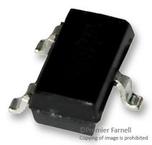Part Datasheet Search > Voltage References > TI > LM385M3-1.2/NOPB Datasheet PDF > LM385M3-1.2/NOPB Datasheet Pages 10/32
LM385M3-1.2/NOPBDatasheet PDF
Page:
of 32 Go
If the format of the manual is confusing, please download and read the original PDF file.

LM3914
SNVS761B –JANUARY 2000–REVISED MARCH 2013
www.ti.com
MODE PIN FUNCTIONAL DESCRIPTION
This pin actually performs two functions. Refer to the simplified block diagram below.
*High for bar
Figure 14. Block Diagram of Mode Pin Description
DOT OR BAR MODE SELECTION
The voltage at pin 9 is sensed by comparator C1, nominally referenced to (V
+
− 100mV). The chip is in bar mode
when pin 9 is above this level; otherwise it's in dot mode. The comparator is designed so that pin 9 can be left
open circuit for dot mode.
Taking into account comparator gain and variation in the 100mV reference level, pin 9 should be no more than
20mV below V
+
for bar mode and more than 200mV below V
+
(or open circuit) for dot mode. In most
applications, pin 9 is either open (dot mode) or tied to V
+
(bar mode). In bar mode, pin 9 should be connected
directly to pin 3. Large currents drawn from the power supply (LED current, for example) should not share this
path so that large IR drops are avoided.
DOT MODE CARRY
In order for the display to make sense when multiple LM3914s are cascaded in dot mode, special circuitry has
been included to shut off LED No. 10 of the first device when LED No. 1 of the second device comes on. The
connection for cascading in dot mode has already been described and is depicted below.
As long as the input signal voltage is below the threshold of the second LM3914, LED No. 11 is off. Pin 9 of
LM3914 No. 1 thus sees effectively an open circuit so the chip is in dot mode. As soon as the input voltage
reaches the threshold of LED No. 11, pin 9 of LM3914 No. 1 is pulled an LED drop (1.5V or more) below V
LED
.
This condition is sensed by comparator C2, referenced 600mV below V
LED
. This forces the output of C2 low,
which shuts off output transistor Q2, extinguishing LED No. 10.
V
LED
is sensed via the 20k resistor connected to pin 11. The very small current (less than 100μA) that is diverted
from LED No. 9 does not noticeably affect its intensity.
An auxiliary current source at pin 1 keeps at least 100μA flowing through LED No. 11 even if the input voltage
rises high enough to extinguish the LED. This ensures that pin 9 of LM3914 No. 1 is held low enough to force
LED No. 10 off when any higher LED is illuminated. While 100μA does not normally produce significant LED
illumination, it may be noticeable when using high-efficiency LEDs in a dark environment. If this is bothersome,
the simple cure is to shunt LED No. 11 with a 10k resistor. The 1V IR drop is more than the 900mV worst case
required to hold off LED No. 10 yet small enough that LED No. 11 does not conduct significantly.
10 Submit Documentation Feedback Copyright © 2000–2013, Texas Instruments Incorporated
Product Folder Links: LM3914

